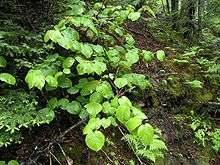Viburnum lantanoides
| Viburnum lantanoides | |
|---|---|
 | |
| Scientific classification | |
| Kingdom: | Plantae |
| (unranked): | Angiosperms |
| (unranked): | Eudicots |
| (unranked): | Asterids |
| Order: | Dipsacales |
| Family: | Adoxaceae |
| Genus: | Viburnum |
| Species: | V. lantanoides |
| Binomial name | |
| Viburnum lantanoides Michx. (1803) | |
| Synonyms | |
|
V. alnifolium Marshall | |
Viburnum lantanoides (commonly known as hobble-bush,[1] witch-hobble, alder-leaved viburnum, American wayfaring tree,[2] and moosewood[3]) is a perennial shrub of the family Adoxaceae (formerly in the Caprifoliaceae), growing 2–4 meters (6–12 ft) high with pendulous branches that take root where they touch the ground. These rooted branches form obstacles which easily trip (or hobble) walkers – hence the common name.
The shrub forms large clusters of white to pink flowers in May–June. The flowers on the outer edge of the clusters are much larger (3–5 cm across). The whole cluster is typically 10 cm across. It has large, cardioid leaves which are serrate, 10–20 cm long. The bark is gray-brown and warty and the fruit is a drupe which is red, turning to black when ripened.
The flowers provide nectar for the Celastrina ladon (Spring Azure) butterfly. Mammals and birds feed on its fruit, twigs, and leaves. The large showy flowers along the edge of the cluster are sterile, while the small inner flowers have both male and female parts.[4]

Distribution
Viburnum lantanoides is found in the eastern U.S. and Canada from Georgia to the Canadian Maritimes.[3] It grows in rich, moist acidic woods, stream banks, and swamps.
References
- ↑ "BSBI List 2007". Botanical Society of Britain and Ireland. Archived from the original (xls) on 2015-02-25. Retrieved 2014-10-17.
- ↑ Brouillet, L., F. Coursol, S.J. Meades, M. Favreau, M. Anions, P. Bélisle & P. Desmet. 2010+. VASCAN, the Database of Vascular Plants of Canada. (consulted on 2014-07-28)
- 1 2 USDA, ARS, National Genetic Resources Program. Germplasm Resources Information Network - (GRIN). National Germplasm Resources Laboratory, Beltsville, Maryland. (28 July 2014)
- ↑ http://www.usanpn.org/Viburnum_lantanoides
External links
| Wikimedia Commons has media related to Viburnum lantanoides. |